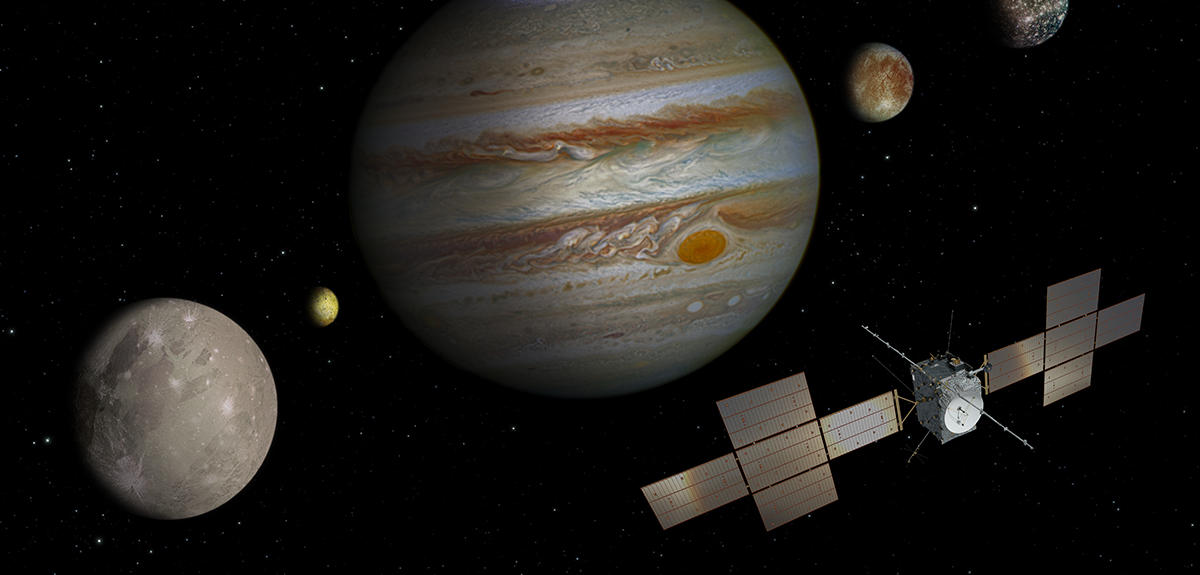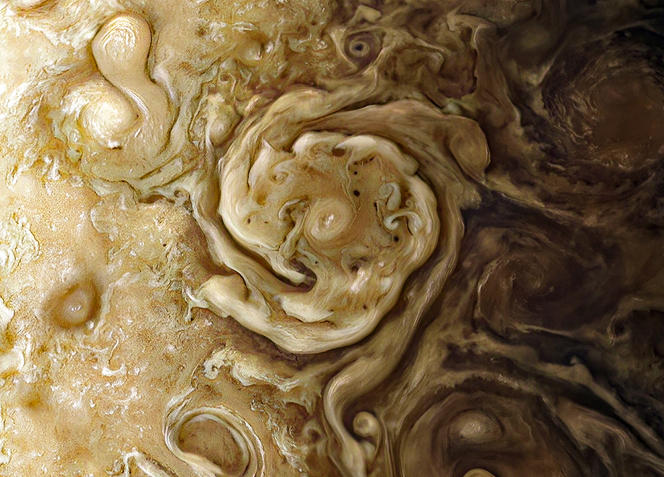You are here
Heading for Jupiter

Jupiter is a planet synonymous with superlatives. Fascination for the Solar System's biggest planet, home to its most powerful storms and surrounded by some of its largest moons, was revived in 2016 with the arrival of the Juno spacecraft, which has since delivered spectacular images and new findings that raise fresh questions. To attempt to answer them, a new mission, JUICE (Jupiter Icy Moons Explorer), will launch in April.
Gas giant and water-rich moons
Led by the European Space Agency (ESA) with the participation of the American and Japanese space agencies (NASA and JAXA) and the involvement of several CNRS laboratories, JUICE is scheduled to arrive in the Jupiter system around July 2031. On the way, it will carry out several flybys of Earth and Venus, as well as the very first gravity assist manoeuvre using both the Earth and the Moon. For at least three years, JUICE will investigate the gas giant, with its turbulent atmosphere, its famous Great Red Spot, its magnetic field, and its rings, as well as three of its four principal (or Galilean) moons: Europa, Callisto and above all, Ganymede.

“An unusual feature of Jupiter's three largest icy moons is the possible presence of liquid water, a few kilometres beneath the ice in Europa's case, at greater depth for the others,” says Olivier Grasset, from the Laboratory of Planetology and Geosciences (LPG),1 who submitted the mission proposal to the ESA.
However, the mission won't be attempting to find alien life. Although JUICE is equipped to detect the possible presence of certain organic molecules, its main goal is to determine whether Jupiter's moons exhibit physical characteristics favourable to the emergence of life, confirm the presence of liquid oceans and calculate their depth and dynamics, as well as study magnetic fields, energy sources, and the stability of environments. It will carry out 21 flybys of Callisto and two of Europa, which will be studied in detail later by the NASA-led Europa Clipper space mission.
The primary target, however, remains Ganymede, the largest moon in the Solar System (bigger than Mercury), and one of the few solid bodies with its own magnetic field. After twelve flybys, JUICE will go into orbit around Ganymede in December 2034 and remain there for nine months, becoming the first spacecraft to orbit a moon other than our own.

Understanding the diversity of the Jovian system
“It's the diverse nature of these objects we’re interested in,” Grasset explains. From Europa's young surface to the ancient craters of Callisto (thought to have the oldest surface in the Solar System, dating back to the very earliest moments of the Jovian system), and from the extensive silicate volcanism of Io to the Moon-like terrain of Ganymede, each of Jupiter’s satellites is a world of its own. And yet they were all born in a similar environment. Exploring this diversity and discovering how the giant planet and its moons formed and evolved will provide valuable clues that should help scientists to improve their understanding of the thousands of exoplanets discovered over the past thirty years. To that effect, the spacecraft is carrying ten scientific instruments, including one under the scientific and technical responsibility of France. This is the Moons and Jupiter Imaging Spectrometer, or MAJIS, for which the French Space Agency CNES is the lead funding agency, and the IAS2 in Orsay (Paris region) the prime contractor, and which benefits from a significant instrumental contribution from Italy.
The instrument will analyse reflected sunlight as well as the intrinsic thermal emission from the objects it points at, covering 1,280 wavelengths ranging from the visible to the infrared. One of its goals is to determine the physical and chemical characteristics of the icy surface of the moons it observes. The chemical composition of this surface is dependent on two principal factors that need to be clearly distinguished in order to understand them better: on the one hand, the moon's internal structure, and in particular its hypothetical ocean of liquid water; and on the other, its interaction with Jupiter's radiation belt which, over time, can profoundly alter the structure of the ice. “Ideally, we'd like to find young terrains whose composition has been only slightly altered, which would allow us to unambiguously characterise the underground ocean,” says François Poulet, an astronomer at the IAS and principal investigator for the instrument.
Extraterrestrial magnetospheres
Other instruments will also contribute to this task, particularly by measuring the effect of Jupiter's magnetic field on the moons and, conversely, the role played by the Galilean satellites in the activity of the gas giant's magnetosphere.
For example, Io's volcanic activity pumps about a tonne of ionised particles per second into Jupiter's magnetosphere, where they are accelerated and cause some of the auroras observed on the gas giant. Since Ganymede also has its own internal magnetic field associated with the characteristics of its ocean, the interactions between the two fields will also be monitored using radio measurements by the Radio and Plasma Wave Investigation (RPWI) instrument.
“The measurement capabilities of our device are unprecedented in the Jupiter system,” says Baptiste Cecconi, an astronomer at the Paris-PSL Observatory in charge of one of RPWI's subsystems. “This ushers in a new stage in its exploration.”



Jupiter has the strongest internal magnetic field of all the planets, over twenty times that of Earth. It is highly asymmetric, stretching 5 million kilometres towards the Sun, and in the opposite direction, forming a 700 million km-long tail that crosses the orbit of Saturn. Explaining its behaviour would provide a glimpse of what is going on in the planet's interior.
Unravelling the mysteries of Jupiter's atmosphere
In a bid to elucidate its composition, structure and dynamics, a number of instruments will also probe the different layers of Jupiter's very large atmosphere, which is mainly made up of hydrogen and helium, two very light gases. Descending towards the centre of the planet, one would sink into an increasingly thick fluid without ever encountering a solid surface, yet perhaps experiencing impressive thunderstorms with winds of up to 540 km per hour at the level of the cloud layer, as well as ammonia-rich hail at deeper levels.
The atmospheric circulation, which is very complex and varies with altitude, is still poorly known, and a host of questions remain unanswered. How has the Great Red Spot – which is bigger than the Earth – managed to last for three hundred years? Why has it been getting smaller over the last century? Is it actually possible to detect the hail predicted by the models? What are the wind patterns above the cloud layer, and what causes such extreme wind speeds? Does the motion observed at the surface, especially that of the well-known coloured bands caused by the presence of different chemical compounds in the clouds, extend into the planet's interior?
JUICE should provide some answers thanks to the exceptional precision of its remote-sensing instruments. “Our detectors can achieve a rate of 4 spectra per millisecond, which is 10,000 times faster than their equivalents on the Galileo spacecraft in the 1990s. That's truly revolutionary!” says Yves Langevin, principal investigator for MAJIS from 2013 to 2019 and now CNRS research professor emeritus at the IAS. The spatial resolution will also be impressive, ranging from under 100 metres to a few kilometres during flybys of moons, and about 125 km/pixel for Jupiter.
Major engineering challenges
Such achievements are the result of the engineering design work carried out at the IAS, where scientists are striving to reproduce the full complexity of the flight conditions. “Jupiter poses major challenges,” explains Cydalise Dumesnil, a CNRS engineer and project manager for MAJIS. Although the solar panels have an area of 85 m2, they only provide limited power, as the sunlight is on average 25 times fainter than on Earth, while the planet's radiation belt can damage the electronics, requiring optimal shielding. An infrared imager also has to be cooled down to prevent its own thermal radiation affecting measurements: “Every extra degree means a drop in performance.” And all of this has to take into account the mass and volume requirements for every instrument in the spacecraft. “You have to find the best compromise to achieve the scientific results you want,” Dumesnil explains.

JUICE is the first major mission in ESA's Cosmic Vision 2015-2025 programme, and brings together 18 organisations from 23 countries, as well as dozens of manufacturers and suppliers. In addition to the latter, over 2,000 people have worked on the project for more than ten years, successfully meeting deadlines despite the problems caused by the COVID-19 pandemic. With so much at stake, expectations for the JUICE mission are understandably running high. And yet ESA doesn't intend to stop there: it has just announced that the first mission in the future Voyage 2050 programme will explore an icy moon orbiting Jupiter or Saturn.
















